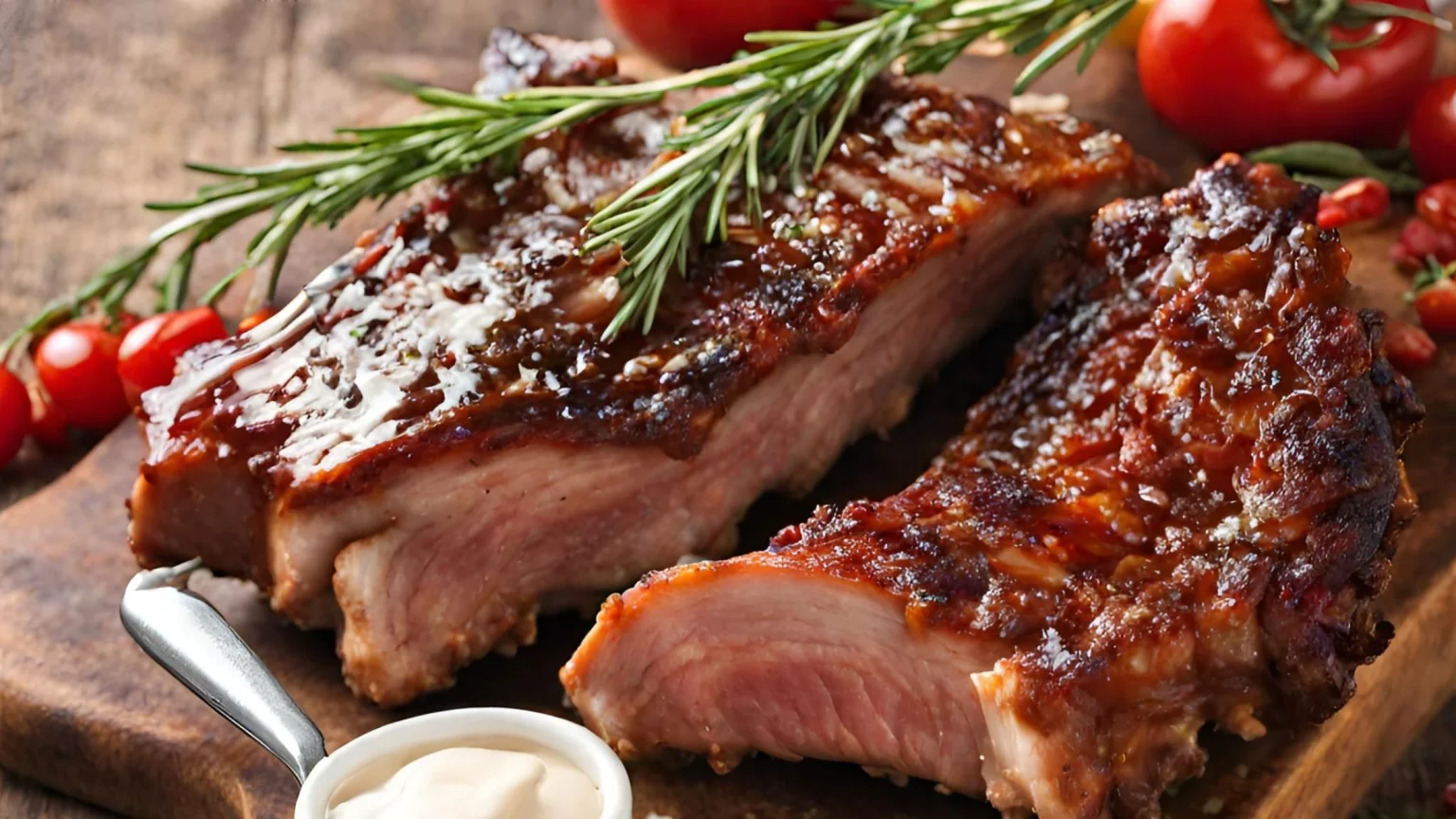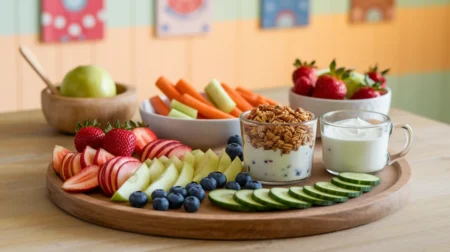When it comes to enjoying a delicious meal, few things can rival the savory satisfaction of sinking your teeth into a juicy rack of ribs. But are those mouthwatering ribs actually healthy to eat? Let’s uncover the nutritional facts to help you make an informed decision about including ribs in your diet.
Key Takeaways:
- Ribs are a good source of high-quality protein.
- They contain essential nutrients like selenium, vitamins B12 and B6, and niacin.
- It is important to consider the fat content, as ribs can be high in saturated fat.
- Moderation is key when consuming ribs due to their fat content.
- Excessive consumption of ribs can increase the risk of heart disease.
Nutritional Benefits of Ribs
Ribs, whether they are pork ribs or beef ribs, are an excellent source of high-quality protein. Not only do they satisfy your taste buds, but they also provide numerous health benefits. Ribs contain essential nutrients like selenium, vitamins B12 and B6, and niacin. These nutrients play a vital role in promoting overall health and wellness.
Protein Benefits:
- Ribs are packed with high-quality protein, which is essential for building and repairing muscles. It helps in cell growth and supports proper immune function.
- Protein is also important for maintaining healthy skin, hair, and nails. It aids in the production of enzymes, hormones, and antibodies.
- A 3-ounce serving of baby back ribs contains approximately 21 grams of protein, making it an excellent choice for individuals seeking to meet their daily protein requirements.
Nutrients and Minerals:
- Selenium: Ribs are a good source of selenium, a powerful antioxidant that helps protect cells from damage and supports a healthy immune system.
- Vitamins B12 and B6: Ribs contain these essential vitamins that play a vital role in metabolism, nerve function, and the production of red blood cells.
- Niacin: Ribs are also rich in niacin, a B-vitamin that supports energy production and helps maintain healthy skin, digestive system, and nervous system.
It is important, however, to consider the fat content when consuming ribs. While ribs contain valuable nutrients, they can also be high in saturated fat. It’s essential to be mindful of portion sizes and choose leaner cuts of meat to limit fat intake.
| Nutrients/Minerals | Amount per 3-ounce serving |
|---|---|
| Protein | 21 grams |
| Selenium | 32.5 micrograms |
| Vitamin B12 | 0.5 micrograms |
| Vitamin B6 | 0.3 milligrams |
| Niacin | 5.2 milligrams |
Ribs: A Good Source of Protein
Ribs are more than just a tasty treat, they also serve as a valuable source of protein. A typical 3-ounce serving of baby back ribs delivers approximately 21 grams of protein, making it an excellent choice for meeting your daily protein needs.
Protein plays a crucial role in muscle formation and repair, as well as supporting various bodily functions. It is made up of amino acids, which are the building blocks of the body’s tissues, including muscles, skin, and organs.
When consumed, protein is broken down into its amino acid components and used to build and repair tissues in the body. It also helps to create enzymes, hormones, and other essential molecules that contribute to overall health and wellness. Ensuring an adequate intake of high-quality protein is vital for maintaining healthy body composition and promoting optimal bodily functions.
However, it’s essential to consume ribs in moderation due to their high levels of saturated fat. While protein is an essential nutrient, excess consumption of saturated fat can increase the risk of heart disease and other health issues. Therefore, it’s important to balance your protein intake from various sources, including lean meats, poultry, fish, legumes, and dairy products, to maintain a healthy dietary pattern.
Protein Comparison: Ribs vs. Other Protein Sources
Let’s take a look at how the protein content of ribs compares to other popular protein sources:
| Protein Source | Protein Content per 3-ounce serving |
|---|---|
| Ribs (baby back) | 21 grams |
| Chicken Breast | 26 grams |
| Salmon | 22 grams |
| Tofu | 8 grams |
| Lentils | 9 grams |
As demonstrated in the table above, ribs provide a significant amount of protein, although there are other sources that may offer higher protein content per serving. Incorporating a variety of protein sources into your diet can help ensure you meet your protein needs while maintaining a balanced and diverse nutritional intake.
Understanding the Fat Content in Ribs
Ribs, especially pork ribs, can be high in fat, particularly saturated fat. A full rack of ribs can contain around 40 grams of total fat, with a significant portion being saturated fat.
If you’re watching your fat intake, it’s important to choose leaner cuts of meat or trim excess fat from the ribs before cooking. Opting for leaner cuts can reduce the overall fat content while still allowing you to enjoy the delicious taste of ribs.
Saturated fat, found in high amounts in ribs, is known to raise cholesterol levels and increase the risk of heart disease. To maintain a healthy diet, it’s crucial to limit your intake of saturated fat and opt for leaner protein sources.
While ribs may be high in fat, they can still be included in a balanced diet when consumed in moderation. By being mindful of portion sizes and choosing leaner cuts of meat, you can enjoy the flavors of ribs while minimizing the impact on your fat intake.
Health Effects and Potential Risks
Consuming ribs in moderation as part of a balanced diet can provide valuable nutrients like iron and zinc. However, it’s important to be aware of the potential health risks associated with excessive rib consumption and certain preparation methods.
Potential Health Risks of Excessive Rib Consumption
While ribs can offer nutritional benefits, overindulging in this high-calorie food can have negative health effects. Excess calorie intake from consuming large quantities of ribs can contribute to weight gain and increase the risk of obesity, which is associated with various health issues such as diabetes and heart disease. Additionally, the high fat content in ribs, especially saturated fat, can elevate cholesterol levels and further increase the risk of heart disease.
The Role of Sodium in Rib Preparation
Ribs, particularly when prepared with barbecue sauces, can often contain high levels of sodium. Excessive sodium intake can lead to health problems like high blood pressure and an increased risk of cardiovascular diseases. It’s essential to be mindful of the sodium content in the sauces used for marinating, basting, or dipping ribs, as well as the overall sodium intake in your daily diet.
Choosing Healthier Options
To minimize potential health risks associated with excessive rib consumption, consider the following suggestions:
- Opt for leaner cuts of ribs or trim excess fat before cooking to reduce the overall fat content.
- Select homemade barbecue sauces with reduced sugar and sodium, or use alternative seasoning options to limit sodium intake.
- Grill or roast ribs instead of deep-frying to reduce calorie and fat intake.
- Enjoy ribs as part of a well-balanced meal that includes a variety of fruits, vegetables, and whole grains to ensure you’re meeting your nutritional needs.
| Health Effects and Potential Risks | Risk Factors | Preventive Measures |
|---|---|---|
| Increased Risk of Obesity | Excess calorie intake | Moderate consumption, portion control |
| Greater Risk of Heart Disease | High levels of saturated fat | Choose leaner cuts, trim excess fat |
| Elevated Sodium Intake | Sauces and seasonings | Select low-sodium options, limit overall sodium in diet |
By being mindful of portion sizes, choosing healthier preparation methods, and paying attention to the overall nutritional content, you can enjoy the taste and benefits of ribs while minimizing potential health risks.
Healthy Cooking Methods and Tips
When it comes to preparing ribs, choosing the right cooking methods can greatly impact their nutritional value. By opting for healthier cooking methods, you can enjoy flavorful ribs while keeping them as healthy as possible.
Grilling or Roasting
One of the best ways to cook ribs is by grilling or roasting them. These methods allow excess fat to drip off, resulting in a leaner final dish. Grilling or roasting also enhances the natural flavors of the meat, creating a delicious meal for any occasion.
Homemade Barbecue Sauce
While store-bought barbecue sauces can be convenient, they often contain high levels of sugar and sodium. To have better control over the ingredients and reduce the overall unhealthy components of your meal, consider making your own homemade barbecue sauce. This way, you can adjust the sugar and sodium content to suit your taste preferences.
Try this homemade barbecue sauce recipe:
- In a bowl, mix together 1 cup of tomato sauce, 1/4 cup of apple cider vinegar, 2 tablespoons of honey or maple syrup, 1 tablespoon of Worcestershire sauce, 1 teaspoon of smoked paprika, 1/2 teaspoon of garlic powder, 1/2 teaspoon of onion powder, 1/4 teaspoon of black pepper, and a pinch of salt.
- Adjust the sweetness and tanginess by adding more honey or vinegar, respectively, and adjust other seasonings to taste.
- Use the sauce to baste the ribs during cooking or as a dipping sauce when serving. Enjoy!
Trimming Excess Fat
Prior to cooking, it’s a good idea to trim any excess fat from the ribs. This can help reduce the overall fat content and make the final dish healthier. Use a sharp knife to carefully remove visible fat, ensuring you retain the meat’s flavor and tenderness.
By following these healthy cooking methods and tips, you can enjoy delicious ribs with better control over the ingredients and a healthier overall meal. Let’s take a look at a nutritional comparison between different cooking methods for ribs:
| Cooking Method | Total Fat (g) | Saturated Fat (g) |
|---|---|---|
| Grilled | 12 | 4 |
| Roasted | 14 | 5 |
| Deep-Fried | 25 | 9 |
As shown in the table above, grilling and roasting ribs result in significantly lower fat content compared to deep-frying. By opting for healthier cooking methods, you can enjoy your ribs guilt-free and maintain a balanced diet.
Conclusion
In conclusion, ribs can be a nutritious and delicious addition to your diet when consumed in moderation. They are a good source of high-quality protein, which is essential for muscle formation and overall health. Ribs also contain important nutrients like selenium, vitamins B12 and B6, and niacin that contribute to your well-being.
However, it is crucial to be mindful of the fat content in ribs. While they provide flavor and tenderness, ribs can be high in saturated fat. To make healthier choices, consider opting for leaner cuts of meat and trimming excess fat before cooking. By doing so, you can reduce the overall fat content and make your ribs a more nutritious option.
Additionally, paying attention to portion sizes and cooking methods can further improve the nutritional value of your meal. Instead of deep-frying, choose healthier cooking methods like grilling or roasting. You can also prepare homemade barbecue sauce with reduced sugar and sodium content to have better control over the ingredients.
Incorporating ribs into your diet can be a delightful experience, but it’s essential to strike a balance. Consuming ribs in moderation as part of a balanced diet can provide you with valuable nutrients while minimizing potential health risks. Remember to listen to your body and make informed choices to support your overall well-being.
FAQ
Are ribs healthy to eat?
Ribs can be a nutritious and delicious addition to your diet when consumed in moderation. They are a good source of high-quality protein and contain essential nutrients like selenium, vitamins B12 and B6, and niacin. However, it’s important to be mindful of the fat content, portion sizes, and cooking methods to improve the overall nutritional value of your meal.
What are the nutritional benefits of ribs?
Ribs, whether they are pork ribs or beef ribs, contain high-quality protein, essential nutrients, and vitamins and minerals. They are an excellent source of protein, with a typical 3-ounce serving of baby back ribs providing around 21 grams of protein. Ribs also contain important nutrients like selenium, vitamins B12 and B6, and niacin.
Are ribs a good source of protein?
Yes, ribs are a good source of protein. A typical 3-ounce serving of baby back ribs provides around 21 grams of protein. Protein is essential for muscle formation and helps maintain overall health and wellness. However, it’s important to consume ribs in moderation due to their high levels of saturated fat.
How much fat do ribs contain?
Ribs, especially pork ribs, can be high in fat, particularly saturated fat. A full rack of ribs can contain around 40 grams of total fat, with a significant portion being saturated fat. It is important to choose leaner cuts of meat or trim excess fat to reduce the fat content.
What are the health effects and potential risks of eating ribs?
Consuming ribs in moderation as part of a balanced diet can provide valuable nutrients like iron and zinc. However, excessive consumption of ribs, especially those prepared with high-sugar or high-sodium barbecue sauces, can increase the risk of heart disease and contribute to excess calorie intake. It is important to be mindful of portion sizes and the overall nutritional content of the meal.
What are some healthy cooking methods and tips for preparing ribs?
To improve the nutritional profile of ribs, opt for healthier cooking methods such as grilling or roasting instead of deep-frying. Consider using homemade barbecue sauce with reduced sugar and sodium content to have better control over the ingredients. Trimming excess fat before cooking can also help reduce the overall fat content.
What is the conclusion about eating ribs?
In conclusion, ribs can be a nutritious and delicious addition to your diet when consumed in moderation. They are a good source of high-quality protein and contain essential nutrients. However, it’s important to be mindful of the fat content, portion sizes, and cooking methods to improve the overall nutritional value of your meal.











